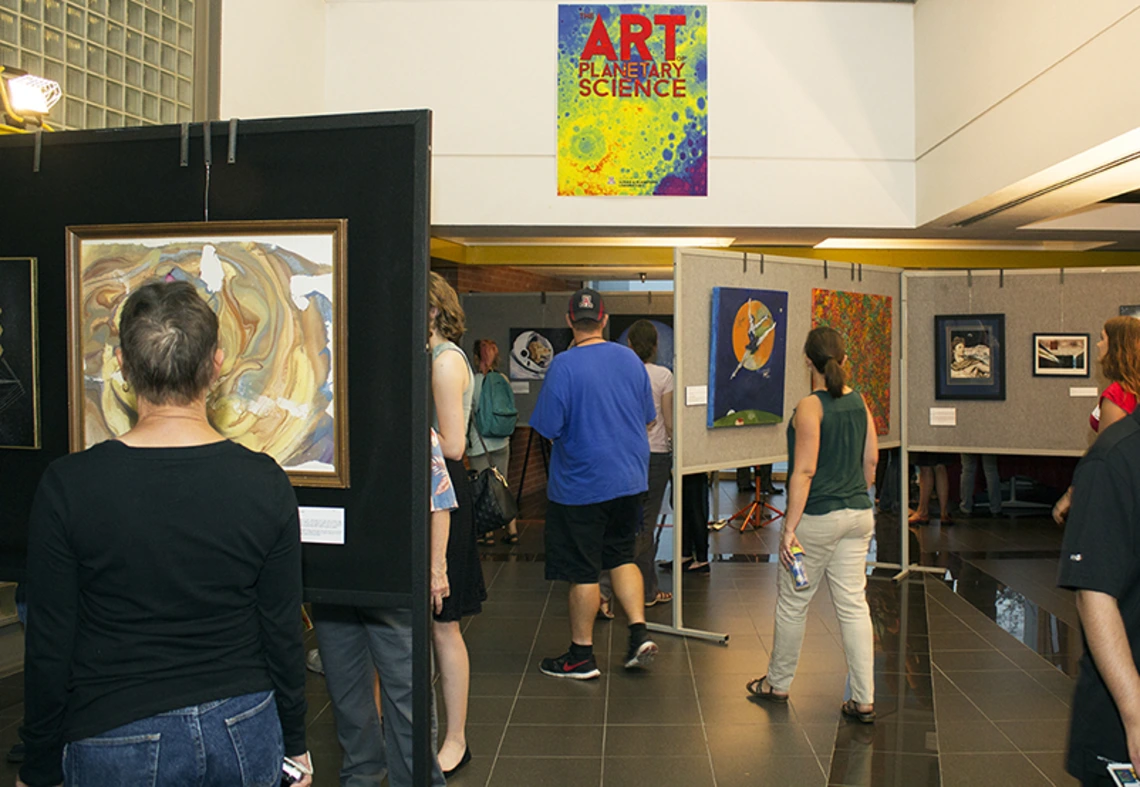UA Students Bring Together Art, Science at Annual Exhibit

The natural beauty of a cluster of galaxies, the bright burst of a nebula and even the star-filled Tucson night sky can be considered forms of abstract art.
This idea motivated four doctoral candidates in the University of Arizona's Lunar and Planetary Lab to create the "Art of Planetary Science" exhibition, which recently had its third annual showing. The exhibit showcases artwork from scientists, artists and aficiondos of both to explore why so many people are fascinated by science and to bring together Tucson's science and art communities.
In doing so, the exhibit fostered an unlikely cross-campus collaboration between the graduate-student organizers from LPL and a class of undergraduates studying art outreach with UA assistant professor Lisa Hochtritt.
Near the entrance, guests were greeted by an interactive chalkboard, which asked people to write about what they felt when when they looked at the sky.
Another exhibit invited participants to color segments of famous equations or to record interviews about their love of science. The interviews will be compiled in video form and posted on the event's website.
Each activity brought together individuals from the community to create a single piece of art, making the activities microcosms of the event as a whole.
"We’re all coming together for this common cause of showing how art and science are really intertwined," said Sarah Carton, one of Hochtritt's students.
The student-run activities were funded by a UA Student/Faculty Interaction grant.
According to the graduate organizers, inclusion of the undergraduates helped make the event a success.
"This was really our best year," said Jamie Molero, addressing Hochtritt’s class after the exhibition. "And you guys were definitely a big part of that."
Colorful topography maps of Earth and Mars brought out the beauty of scientific models. A photograph of the night sky showed the constellation Delphinus — "dolphin" in Latin — diving into the Milky Way, a playful interpretation of the stars. Artistic renderings of NASA photographs showed the cosmos as a natural inspiration for abstract art.
Although paintings and photographs dominated the show, there also were quilts, Lego creations and other unique pieces. Sarah Peacock, one of the organizers, even contributed a piece based on ancient Incan traditions.
"I was working in Chile and I learned the Incas used to make 'quipus,' which is a way of counting agriculture by tying knots in strings," Peacock said.
She created her own color-coded quipus, which counted the number of discovered exoplanets in different regions around their star. For instance, green strings represented the number of known exoplanets in the habitable zone, while red strings represented the number of exoplanets located extremely close to their star.
Several other pieces focused on the way indigenous folklore has represented the cosmos throughout time, serving as a reminder that humans studied the cosmos even before the creation of modern science.
The project also helped students rediscover their own love of science.
"I jumped around majors a lot, and now I’m a photography major," said Curtis Ryan, one of the undergraduate volunteers. "But I think if I could go back, I would do astronomy."
Several students expressed similar sentiments. They were passionate about art but still wished to pursue their interest in science.
"A lot of students in the art department have a lot of interest in science," Carton said. "So it was really great to bring us together, from literally opposite sides of the campus."
The exhibit also rekindled a desire to make art.
"This class has opened up old avenues I used to explore, like music and painting," said Brysen Brown, a general studies major with a focus in economics. "I’m actually painting now!"

